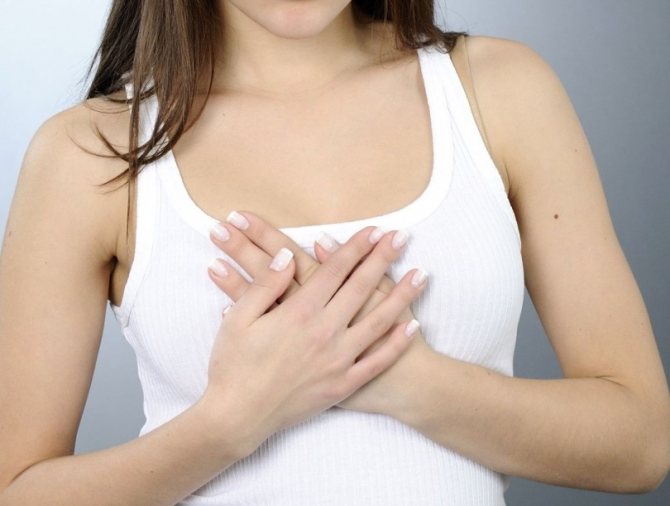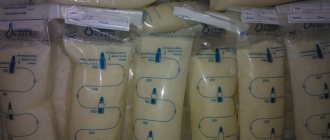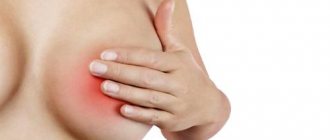During breastfeeding, a nursing mother may experience problems with her breasts. Especially often young mothers who have had their first child suffer from this, since before this event there was no experience of putting the baby to the breast. When the mammary glands cause a woman discomfort, pain, and an increase in temperature occurs, this indicates that a disease is beginning: lactostasis or mastitis. How do they differ, and how to fight these diseases?
Etiology
If during breastfeeding your breasts hurt and your temperature suddenly rises sharply, the cause of this phenomenon may be advanced lactostasis or mastitis.
Causes of lactostasis:
- the structure of the breast, which provokes the formation of a milk plug;
- squeezing the breast with your hand when feeding, sleeping on one side, feeding in an awkward position, wearing tight clothes, etc.;
- prolonged pumping;
- stress causing spasm of the milk ducts;
- chronic fatigue;
- high fat content of milk;
- using a pacifier that changes the baby's sucking technique;
- hard work with monotonous hand movements.

Lactostasis sometimes develops into mastitis.
Factors that provoke mastitis:
- irregular feeding or feeding at intervals of more than 2 hours;
- constant milk residues in the breast;
- cracks in the nipples through which infection penetrates;
- anemia, reduced immunity;
- violation of hygiene standards and poor breastfeeding care;
- tight, hard bra;
- hypothermia;
- improper feeding of the child, poor, incomplete pumping;
- viral infections;
- history of breast pathologies;
- complications during delivery, suppuration.
What is the difference between lactostasis and mastitis?
If a nursing mother has breast pain and fever, this condition can be caused by both lactostasis and mastitis.
Stagnation of milk, especially in primiparous women, can be difficult to distinguish from the onset of mastitis.
Their symptoms are largely the same, but there are also differences.
A sign of mastitis is a sharp increase in temperature to 39°C accompanied by swelling of the nipple, chills, and chest pain.
With lactostasis, the duct becomes clogged, local compaction and redness of the skin occurs, and the temperature is low. If this condition lasts a week or more, mastitis may develop.
Preventive actions
To avoid the development of serious diseases that can affect the female body during lactation, it is recommended to follow preventive measures. Just a few simple requirements that are strictly followed will help you maintain health and get only pleasure from feeding your baby.

You can prevent milk stagnation by following these medical recommendations:
- Avoid drafts and prolonged exposure to cold or frosty air. During the lactation period, the mammary glands are most sensitive and susceptible to diseases; they are easy to catch a cold, which, if left untreated, can develop into a serious problem.
- Make sure you have comfortable underwear in advance. During lactation, breasts increase significantly; old bras will rub and press on the delicate skin, which will lead to the formation of cracks and cause stagnation of milk. Choose clothes made from lightweight natural materials, without hard, hard parts.
- During pregnancy, begin to harden the mammary glands - pour cool (not ice) water over them, massage with a hard towel.
- Before each feeding of the baby, rinse the breasts and hands (use soap), and complete the process with water procedures.
- The appearance of cracks should not be ignored; you should immediately consult a doctor and purchase an ointment that promotes tissue healing. There is no need to wean the baby from the breast - most drugs act instantly, acting locally, without penetrating into the product produced by the mammary glands.
- Avoid mistakes when feeding your baby. You can consult a doctor, ask what position to choose for attachment (especially with nipple defects), how often to feed, and what to pay attention to during the process.
Just following these rules is enough to ensure that lactostasis and mastitis are not disturbed during lactation, breastfeeding occurs without unpleasant events, frequent visits to the doctor and long-term treatment.
Lactostosis and mastitis are dangerous diseases for women’s health that require immediate treatment with medications. Young mothers should not forget that experimenting with home remedies and delaying a visit to the doctor, first of all, they harm the child. Self-medication can lead to the disappearance of milk, the premature end of lactation - you will have to transfer the baby to artificial formulas, which are less useful than breast milk, which is replete with the substances the baby needs for the rapid growth and development of a small organism.
Types and symptoms of mastitis

With mastitis, the chest hurts, the temperature is 38°C or higher, the symptoms progress quickly. If left untreated, one stage can change to another in just 3 days.
Types of mastitis
- Serous.
- Infiltrative.
- Purulent.
The serous variety is not characterized by high fever; the breasts become enlarged and painful.
Infiltrative mastitis is manifested by compactions, upon palpation of which unbearable pain is felt. The temperature is very high, the skin on the chest turns red, becomes hot and elastic.
In the purulent form, the breast swells greatly, becomes enlarged, turns red at the site of inflammation, and hurts unbearably even with a light touch. Migraines and weakness occur. There is noticeable pus in the milk, the lymph nodes in the armpits are enlarged. Temperatures can reach 40°C and then drop, fluctuating.
With unilateral suppuration, you can feed the baby, but only with a healthy breast, since bacteria can easily be transmitted to the newborn.
How to recognize lactostasis?
Chest pain, temperature above 38 degrees are the main symptoms indicating the development of lactostasis. The disease is serious, accompanied by stagnation of milk, blockage of the ducts. Typically, the disease develops in the first months after the birth of a toddler, when the body is not fully adjusted to lactation.
Errors in feeding contribute to the development of the disease - improper attachment of the baby to the mammary glands, non-compliance with the daily routine by the mother - lack of sleep, fatigue. In order to prevent lactostasis, it is recommended to consult a doctor in the maternity hospital on how to properly feed your baby, care for your breasts, and what clothes to choose.
If the temperature of 37 degrees lasts for more than three days, chest discomfort does not disappear even after pumping and frequent feedings of the baby, you should immediately go to the doctor. The use of special gels, ointments, regular massaging of the mammary glands, and taking medications will help stop the disease in a timely manner.
Diagnostics
When the chest hurts and there is a fever during breastfeeding, some signs (red painful spots on the chest, high temperature) can be used to self-diagnose mastitis. But at an early stage it is difficult to distinguish it from milk stagnation.
If you suspect mastitis, you should not start treatment on your own without consulting a gynecologist and laboratory test data. Mastitis needs to be treated as quickly as possible, and without identifying the specific pathogen, it is impossible to choose the right drug or folk remedy. In addition, traditional methods are not designed for quick results.
Diagnostics includes examination by a mammologist, ultrasound, blood testing, and breast milk testing.
If the diagnosis of mastitis is confirmed, based on the research, antibiotics will be prescribed, including some modern agents that can also be used during feeding.
Why is self-medication dangerous?

Self-medication is dangerous because it does not completely get rid of the infection, when the symptoms temporarily stop, but at this time the bacteria continue to divide and the inflammatory process flares up with renewed vigor. The application of cabbage leaves and other remedies that may be useful in the treatment of lactostasis are inappropriate for the treatment of mastitis. Home remedies are slow-acting and are ineffective for severe infections. As a result, the disease will progress.
Therefore, when your chest hurts and your temperature rises even slightly during feeding, the algorithm of action should begin with a trip to the doctor.
Therapy
The basic principle of mastitis treatment is regular and complete pumping procedures. For this purpose, it is convenient to use a high-quality, expensive breast pump or ask your husband for help.
Since the newborn can be breastfed at an early stage, feeding should begin with the sore breast, even if there is pain. Before the process, drop 4 drops of Oxytocin under your tongue to enhance milk flow and eliminate spasms. You can also take a warm (but not hot) shower and massage your breasts a little with light circular movements towards the nipples. Then you need to express the remaining milk manually and using a breast pump until the feeling of heaviness disappears. After the procedure, apply ice wrapped in cellophane and cloth to your chest for 15 minutes.
Actions must be repeated every 2 hours, including at night. At the same time, it is important to correctly attach the baby to the breast - so that the lower lip is in the place of hardening.
Taking most antibiotics needed to treat advanced mastitis is a contraindication to feeding.
With normal milk stagnation, drug therapy may not be required.
Particularly severe cases of purulent mastitis can only be treated surgically, so it is important not to neglect the pathology.
Symptoms and signs
It is quite simple to recognize lactostasis in a nursing mother. The first sign of its development will be severe discomfort in the mammary gland, which will very soon be joined by pain. In this case, the breasts will become dense and swollen, and hypermia of the skin often occurs at the site of stagnation of milk. Later, a compaction similar to a small ball will appear in its place. In parallel with this, body temperature also rises to 37 - 38 degrees. Its maximum increase can be up to 39 degrees; a very high temperature is not typical for lactostasis. It should be noted that the nursing mother should measure it at the bend of the elbow. During lactation, the temperature in the armpits will be slightly elevated. With lactostasis, there is a temperature imbalance - on the side affected by breast congestion, it will be above 37 degrees.

At this stage of development of milk stagnation, when the pain is not yet too severe, you can still cope with this disease on your own. And the baby himself will help with this, which should be applied to the affected breast as often as possible, and between feedings use a breast pump. If no help was provided at the first signs of lactostasis, the symptoms of milk stagnation in the mammary gland begin to progress. The chest increases in size, becomes hot and swollen, body temperature has risen above 37 degrees, and is accompanied by severe fever, dyspeptic disorders and general malaise. At this stage, it is difficult, almost impossible for a baby to latch on to the breast, since the general flow of milk is disrupted and it becomes very hard. Expressing yourself turns into a painful procedure.
Prevention
Prevention of mastitis and lactostasis includes:
- local hardening of the nipples, for example, daily washing of the breasts with cool water, wiping with a rough towel, starting from the gestation period;
- washing hands and breasts before breastfeeding;
- correct attachment to the breast of a newborn;
- timely elimination of cracks in the nipples - a source of penetration of pathogenic bacteria into the mammary glands;
- feeding in the first month at the child’s first request;
- using comfortable bras without hard parts cutting into the body.
Breastfeeding women should avoid drafts and breast impacts. If you have a history of mastitis, it is recommended to express milk after each feeding (but this is a controversial point). Thus, preventing blockage of the milk ducts lies in proper, frequent and regular feeding. If there are congestive processes in the chest, you should immediately consult a doctor so that lactostasis does not develop into mastitis.
Development of mastitis
If adequate assistance was not provided at this stage, then when an infection occurs, for example, from cracks in the nipples, mastitis develops. He can be:
- serous;
- infiltrative;
- purulent.
The signs of its serous stage are similar to the symptoms of lactostasis - an increase in body temperature up to 37 degrees, pain in the mammary gland, its swelling and hypermia. When it enters the infiltrative stage, these signs include an increase in axillary lymph nodes on the side of the affected breast, difficulty expressing breast milk, and the appearance of a lump in the mammary gland.
The transition of mastitis to a purulent form is accompanied by an increase in body temperature to 40 degrees, as well as the appearance of purulent discharge from the nipple and the skin of the affected gland acquiring a bluish tint. These symptoms indicate that a purulent area has formed at the site of milk stagnation.
Purulent mastitis requires hospitalization of the woman in a hospital and temporary weaning of the baby from feeding. After powerful antibiotic therapy, you can return to breastfeeding. But it’s better, of course, not to reach this stage of milk stagnation.








